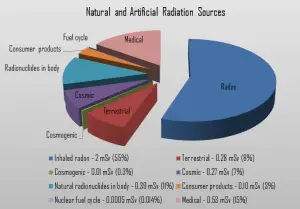 Radiation is all around us. In, around, and above the world we live in. It is a natural energy force that surrounds us, and it is a part of our natural world that has been here since the birth of our planet. From the beginning of time, all living creatures have been, and are still being, exposed to ionizing radiation. Ionizing radiation is generated through nuclear reactions, nuclear decay, very high temperature, or acceleration of charged particles in electromagnetic fields.
Radiation is all around us. In, around, and above the world we live in. It is a natural energy force that surrounds us, and it is a part of our natural world that has been here since the birth of our planet. From the beginning of time, all living creatures have been, and are still being, exposed to ionizing radiation. Ionizing radiation is generated through nuclear reactions, nuclear decay, very high temperature, or acceleration of charged particles in electromagnetic fields.
Radiation Exposures from Nuclear Fuel Cycle
The nuclear fuel cycle is a process chain consisting of various stages. In general, the nuclear fuel cycle consists of steps in the front end (the preparation of the fuel), steps in the service period (fuel burnup), and steps in the back end (reprocessing or disposal of spent nuclear fuel). Radiation exposures from the nuclear fuel cycle are, according to UNSCEAR, evaluated from the entire life cycle of nuclear fuel, and this includes:
- uranium mining, milling and mill tailings,
- fabrication of fuel assemblies
- power plant operation (except accidents),
- spent fuel storage or reprocessing,
- disposal of radioactive waste,
- decommissioning activities.
The collective dose, which results from the nuclear fuel cycle, is:
- 130 man Sv for nuclear fuel cycle,
Almost half of the contribution to public exposure from the nuclear fuel cycle comes from discharges of natural radionuclides during uranium mining and milling activities.
The normalized collective dose (per gigawatt and year) is:
- 0.43 man Sv/GW.a (man sievert per gigawatt year) for nuclear fuel cycle
Special Reference: Sources and effects of ionizing radiation, UNSCEAR 2016 – Annex B. New York, 2017. ISBN: 978-92-1-142316-7.
In the following points, we try to express ranges of radiation exposure from electricity generation and doses, which can be obtained from various sources.
- 05 µSv – Sleeping next to someone
- 09 µSv – Living within 30 miles of a nuclear power plant for a year
- 1 µSv – Eating one banana
- 3 µSv – Living within 50 miles of a coal power plant for a year
- 10 µSv – Average daily dose received from natural background
The above doses are related to public exposure. If we consider occupational exposure regarding uranium mining, power plant workers, etc., the collective dose is higher, especially for uranium miners. The miners are surrounded by rocks and sloshing through groundwater exuding radon.
Note that the collective effective dose is often used to estimate the total health effects, but according to the ICRP, this should be avoided.